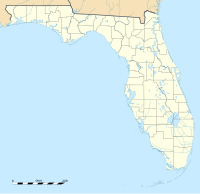Egmont Key
| Egmont Key State Park & National Wildlife Refuge | |
|---|---|
|
IUCN category IV (habitat/species management area)
|
|
 |
|
| Location | Hillsborough County, Florida, United States |
| Nearest city | St. Petersburg, Florida |
| Coordinates | 27°35′11″N 82°45′41″W / 27.58625°N 82.761389°WCoordinates: 27°35′11″N 82°45′41″W / 27.58625°N 82.761389°W |
| Area | 328 acres (1.33 km2) |
| Established | 1974 |
| Governing body | Florida Department of Environmental Protection |
| Website | Egmont Key State Park |
|
Egmont Key
|
|
| Coordinates | 27°35′24″N 82°45′46″W / 27.59000°N 82.76278°W |
| Area | 450 acres (182 ha) |
| Built | 1840 |
| NRHP Reference # | 78000946 |
| Added to NRHP | December 11, 1978 |
Egmont Key State Park is a Florida State Park located on Egmont Key, at the mouth of Tampa Bay, in the state of Florida, United States. It lies southwest of Fort De Soto Park and can only be reached by boat or ferry. The Egmont Key Lighthouse and the ruins of Fort Dade, a Spanish–American War era fort, are located in the park. Egmont Key is in Hillsborough County in a narrow strip of the county that extends along the Tampa Port Shipping Channel.
Located on the south end of the island is the Egmont Key National Wildlife Refuge, which was established in 1974. It is one of the three 'Tampa Bay Refuges' and is administered as a part of the Chassahowitzka National Wildlife Refuge Complex.
Egmont Key was added to the U.S. National Register of Historic Places on December 11, 1978.
Among the wildlife in the park are gopher tortoises, hummingbirds, and seabirds.
Activities include sunbathing, swimming, shelling, boating, picnicing, snorkeling ,touring the fort, and wildlife viewing. Amenities include beaches, nature trails, and picnic tables. Food, water, and restrooms are not available in the park. No alcoholic beverages or pets of any kind are permitted on the island.
...
Wikipedia

